How to get maximum benefit, spending minimum money? Heating a country house: options and prices
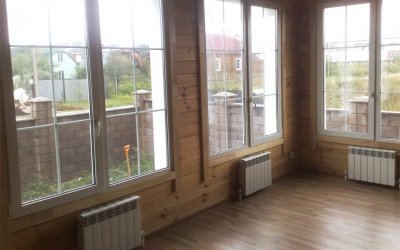
Many modern types of heating are suitable for a private home. The key reasons for choosing are availability of communications, fuel and equipment.
Heating using main gas is considered the most economical and convenient.
Heating with wood will bypass 2.5 times more expensive, and electricity is more expensive up to seven and a half times, than gas.
The price of equipment, installation and operation depends on the manufacturer, the quality of the building insulation, the climate zone and other factors.
Heating a country house: options and prices
There are many different ways to heat a country house.
Autonomous
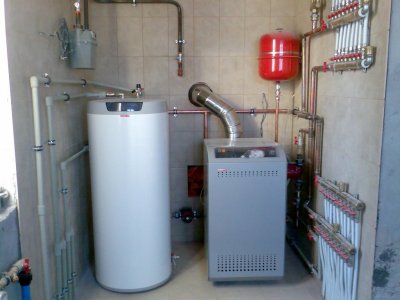
The difference between this type of heating and centralized heating is in the location of all components of the heating system directly in the heated building.
In Russia, for year-round autonomous heating, they often use water heating using a boiler:
- gas;
- solid fuel;
- electrical.
A water heating circuit with pipes and radiators is connected to the boiler, diluted in most rooms of the house. The coolant (water or antifreeze) is heated by the boiler and moves through the pipes, heating the surrounding space.
Autonomous water heating system diagram
- boiler;
- pipes;
- radiators;
- chimney (not needed when using an electric boiler);
- pump;
- boiler;
- expansion tank;
- security group, etc.
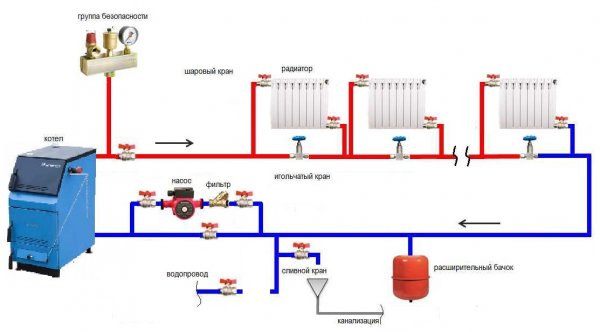
Photo 1. Scheme of autonomous heating of a country house. A solid fuel boiler is used as a heat source.
For small gasified houses Double-circuit boilers are often used, providing both heating and water heating, which eliminates the need to additionally install a boiler.
Important! The use of water in the heating system requires maintaining a positive temperature in the house in the cold season or draining liquid from the structure during periods of frost.
Pros
- Possibility to organize the system according to individual needs owners (use of heated floors, different temperature conditions in individual rooms, etc.).
- Heating in a remote location.
- Independence from the presence of a centralized authority heating, a general schedule of shutdowns and imposed temperature conditions.
- Cheaper heating at home using mains gas.
- Wide range of options (liquid, air, wood, infrared, etc.).
Cons
- The need to do And repair the system yourself.
- Complexity of calculations.
Attention! Errors in calculations and design of the heating system lead to excessive consumption of resources and poor quality heating. It's better to contact professionals.
- High cost in the absence of main gas.
- Labor intensity when heated with wood.
- Possibility of fire And gas leaks.
- Various requirements and approvals when connecting to the gas pipeline.
Approximate cost
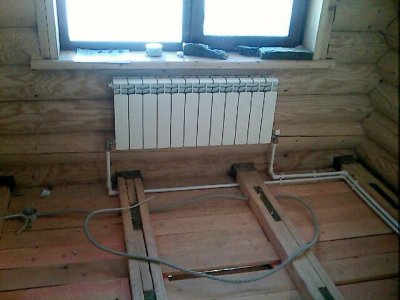
The price of the system depends on the type of boiler and other equipment, the area of the house, and the degree of automation.
If the economy version of the liquid design for a building of 100 sq. m. with a double-circuit boiler (without a separate boiler for heating water) will cost, for example, 160 thousand rubles.
The cost of a premium heating system with automatic temperature control and a separate boiler will exceed half a million rubles.
Operating costs depend on the type of fuel. Example for gas heating of a house in 100 sq. m. (main gas): boiler 10 kW uses 1 cu. m of gas per hour. If it works at full capacity within a month, then it will be required 720 cubic meters of gas. The indicator is multiplied by the gas tariff in the region to find out the maximum heating costs in this way.
Reference. Gas consumption for heating depend on the boiler efficiency and gas type. The cost is calculated according to the formula provided on the Internet for different boilers before purchase. Differences in operating costs will help make the right choice.
Centralized
This option is more common for apartment buildings. But can also be used for small buildings.
Operating principle
The boiler room heats the coolant and supplies it to the heat receiving point, where its temperature is adjusted. Then, through a system of pipes, the coolant enters the heated buildings, equipped with meters, filters and valves. Each house has a piping system with radiators (batteries), by means of which heating is produced.
Scheme
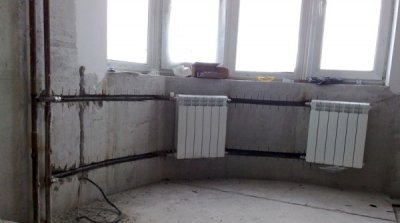
- source of energy (boiler room or thermal power plant);
- central heating station (with heat exchanger, circulation and make-up pumps);
- heating networks (water pipes);
- equipment for each specific home with distribution throughout the premises.
Pros
- Saving time for private consumers for the creation of a heating system and its operation.
- Professional calculation and equipment heating.
- The ability to optimize costs for a large number of consumers at once (for example, when switching a boiler room to an economical type of fuel from fuel oil to gas).
- With efficient systems, heating is cheap.
Cons
- Individual needs are not taken into account. The heating is turned on and off according to a single schedule.
- High cost of heating with inefficient systems or operating companies.
- Conversion is impossible or extremely difficult (for example, using heated floors).
- A service is imposed when there is no need for it (People have to pay to heat even unused apartments).
- Accidents can lead to power outages heating to a wide range of consumers at once.
- Hot water outages.
Approximate cost
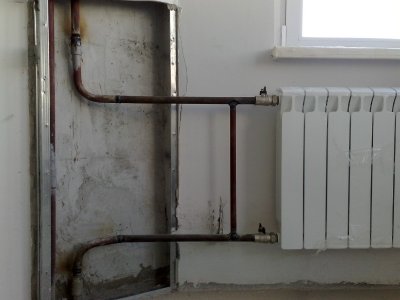
Price of central heating for a private house above individual heating both when connecting and during operation.
To connect, technical specifications and a project are required (both of which cost 10-15 thousand rubles).
The laying of pipes is also taken into account (cost example: 2 thousand rubles per meter), the device of the elevator unit (prices are called from 50 to 500 thousand rubles), connection to the main line (about 10 thousand rubles).
The operating tariff is individual for each heat supply company and depends largely on the fuel used (Fuel oil increases cost heating approximately twice as much compared to gas).
Important! Whatever heating system is chosen, The house needs to be well insulated.
Water
This type of heating more often used in RussiaIn some other countries, preference is given to air heating, which is more economical and lacks a number of the disadvantages of liquid systems.
Operating principle
Regardless of the energy source (gas, solid fuel or electric boiler) the design includes pipes and radiators with a liquid heat carrier. The boiler heats the liquid, and the heat from it is distributed throughout all the rooms of the house.
Pros and cons of liquid heating depending on the type of boiler
- Gas
- Pros: low cost of heating with central gas supply, possibility of fully automating heating;
- cons: high costs for imported gas, a large number of requirements and the need for approvals when connecting to the main line, energy dependence.
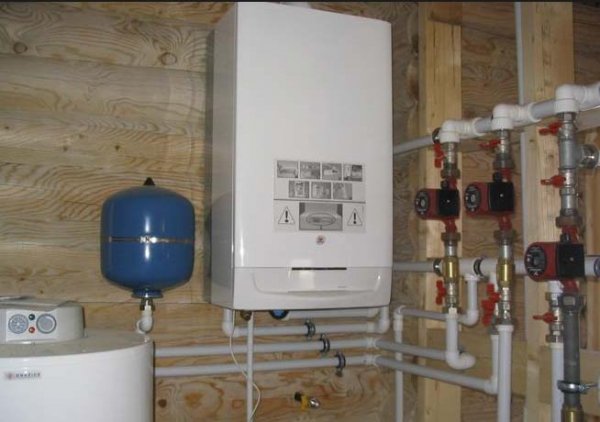
Photo 2. Heating a country house using a gas boiler. The device is connected to a water circuit with an expansion tank.
- Solid fuel
- Pros: independence of heating from the presence of gas, availability of fuel;
- cons: high cost of heating and labor (can be reduced in long-burning boilers and by installing automated storage units), risk of fire.
- Electric
- Pros: the system is fully automated, electrification is simpler and cheaper than gasification, the boiler is inexpensive, does not require a chimney, special premises and approvals, like a gas boiler;
- cons: high cost of electricity, for some types of electric boilers there is a risk of electric shock from the heating system.
Gas air
It can be not only liquid, but also air-based. In addition to main gas, gas in cylinders is used, or a gas holder (private gas storage) is installed. Liquefied gas is significantly more expensive than main gas.
The principle of operation of air gas heating
Instead of a liquid coolant, air is used. It is heated by a gas heat generator. and enters through the air duct system directly into the heated rooms. Through other air ducts, the warm masses return back, partially mixing with the outside air.
Scheme
- a boiler room in the basement, including a heat generator, fan, cleaner and other equipment;
- air duct system (central and side);
- set of ventilation holes.

Photo 3. Air heating of a private house. Air ducts are located under the ceiling, they are hidden behind special panels.
Pros
- Up to 1.5 times more economical water gas heating.
- Fast warm-up premises.
- Pipes do not spoil the interior.
- There is no risk of pipe bursting when freezing.
- Lots of additional features (air conditioner, humidifier).
- Safety.
Cons
- Difficulties of installation and the need for equipment maintenance.
- Energy dependence.
Approximate cost
One of the installation examples contains the following data: for home 96 sq. m. in two floors The cost of installing the air heating system was in 2012 prices 245 thousand rubles.
The operating cost can be initially taken as a value 1.5 times lower, than the calculated gas heating of the same house with a water circuit. A more accurate calculation is possible using special formulas and data from the equipment used.
Heating a house with electricity
Electric heating has several varieties.
Types
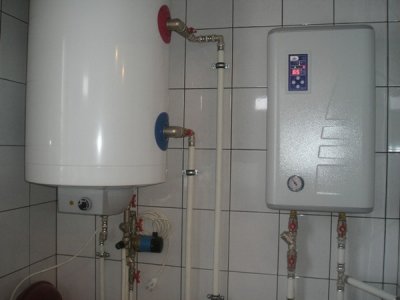
There is a wide range of different equipment for such heating on the market. depending on its types:
- using electric boilers;
- infrared heating;
- heating with convectors;
- heated floors;
- electric fireplace;
- oil heaters;
- fan heaters;
- ceramic electrical panels;
- electric rugs.
Operating principle
It is different for each type of equipment. For electric boilers This is the transfer of energy to the coolant by heating elements. For infrared heating — heating objects in a room with infrared rays. For electric convectors It is characterized by the passage of air through special holes to the heating element located inside the device and heating the room with warm air.
Pros
- For heating the house connection to the power grid is sufficient.
- Speed of organization heating with a number of devices.
- Possibility of automation and remote control.
Cons
- High cost electricity.
- Electromagnetic radiation.
Approximate price
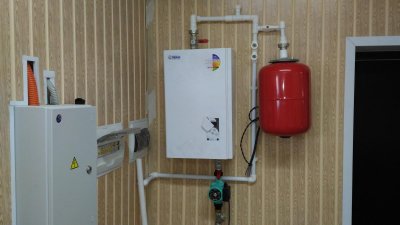
An option suitable for use in a small, well-insulated room. Necessary equipment: oil radiator costing 2 thousand rubles and power 1.5 kW.
When used around the clock within a month (30 days) at full capacity will require 1080 kW electricity. At a price 4.25 rubles the costs will amount to 4590 RUR per month. To save money, use a two-zone tariff.
Stove heating of a country house without gas
Stove heating can be:
- using a water circuit;
- without him.
In the first case The furnace serves to heat the coolant, which, in turn, heats the surrounding space. In the second the stove itself heats the room. Brick equipment is used for long cooling.
Scheme
Includes stove and chimney.
Attention! In case of poor quality insulation of the chimney Fires are possible.
Pros
- Independence heating from communications.
- Possibility of use ovens too for cooking.
- Fuel availability.

Photo 4. Heating a country house using a brick stove. You can also cook food on the hob.
Cons
- High labor costs during operation (filling the firewood every few hours).
- Long warm-up premises.
- Possibility of fire and carbon monoxide poisoning.
Approximate price
From 4 thousand rubles there is a metal stove with a chimney, on which food is also cooked. It uses any fuel, including chopped deadwood, which is obtained free of charge. The option is suitable for heating a summer house for a short period of time.
Useful video
Watch the video, which talks about the most efficient and inexpensive options for heating a country house.
Calculations and consultations with specialists are the key to a successful choice
In the variety of heating equipment available on the market It's easier to figure it out with the help of experts. It is important to make the calculations and design correctly, otherwise the heating of the house risks being of poor quality.
It is worth studying new relevant methods heating, some of them are much more economical than traditional ones.







